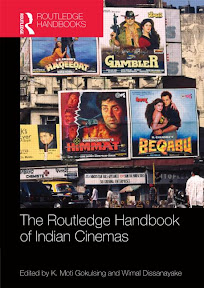Gokulsing, K. Moti [u.a.] [Hrsg.]:
Routledge Handbook of Indian Cinemas / ed. by K. Moti Gokulsing and Wimal Dissanayake. Editorial assistant Rohit K. Dasgupta. - London and New York : Routledge, 2013. - ca. 486 S.
ISBN 978-0-415-67774-5
£ 120,00 (Hardback)
DDC: 791.430954
-- Angekündigt für April 2013 --

Beschreibung
India is the largest film producing country in the world and its output has a global reach. After years of marginalisation by academics in the Western world, Indian cinemas have moved from the periphery to the centre of the world cinema in a comparatively short space of time. Bringing together contributions from leading scholars in the field, this Handbook looks at the complex reasons for this remarkable journey.
Combining a historical and thematic approach, the Handbook discusses how Indian cinemas need to be understood in their historical unfolding as well as their complex relationships to social, economic, cultural, political, ideological, aesthetic, technical and institutional discourses. The thematic section provides an up-to-date critical narrative on diverse topics such as audience, censorship, film distribution, film industry, diaspora, sexuality, film music and nationalism.
The Handbook provides a comprehensive and cutting edge survey of Indian cinemas, discussing Popular, Parallel/New Wave and Regional cinemas as well as the spectacular rise of Bollywood. It is an invaluable resource for students and academics of South Asian Studies, Film Studies and Cultural Studies. [Verlagsinformation]
Inhalt
List of illustrations. ix
List of contributors. x
Acknowledgements. xv
1. K. Moti Gokulsing and Wimal Dissanayake:
Introduction. 1
PART 1: HISTORICAL ANALYSIS
2. M. Madhava Prasad:
From Cultural Backwardness to the Age of Imitation: An Essay in Film History. 7
3. Ira Bhaskar:
The Indian New Wave. 19
4. Regional Cinemas
4.1 Sharmistha Gooptu:
'Bengali' Cinema: Its Making and Unmaking. 37
4.2 Manoj Barpujari:
Assamese Cinema: Dreams, Reality and Dichotomies. 51
4.3 Shyamhari Chakra:
Odia (the new name for Oriya) Cinema at seventy-five. 63
4.4 Amrit Gangar:
Marathi Cinema: The Exile, the Factory and Fame. 72
4.5 Amrit Gangar:
Gujarati Cinema: Stories of Sant, Sati, Shethani and Sparks so few. 88
4.6 Meena T. Pillai:
Matriliny to Masculinity: Performing Modernity and Gender in Malayalam Cinema. 102
4.7 M. K. Raghavendra:
Kannada Cinema and Princely Mysore. 115
4.8 S. Theodore Baskaran:
The Star-politicians of Tamil Nadu: The origin and emergence. 127
4.9 Joe Christopher:
Beyond the Star: Telugu Comedy Films and Realpolitik in Andhra Pradesh. 137
4.10 Ratnakar Tripathy:
Mapping the invisible world of Bhojpuri cinema and its changing audience. 150
4.11 Prabhjot Parmar:
From Lahore to Bombay ... to Vancouver: The Chequered Journey of Punjabi Cinema. 162
PART 2: THEMES AND PERSPECTIVES
5. Shoma A. Chatterji:
The evolution of representing Female sexuality in Hindi Cinema 1991-2010. 179
6. Rama Srinivasan:
Queer Times in Bollywood. 193
7. Jigna Desai:
The Scale of Diasporic Cinema: Negotiating National and Transnational Cultural Citizenship. 206
8. Vijay Devadas:
The Shifting Terrains of Nationalism and Patriotism in Indian Cinemas. 218
9. Aniruddha Dutta:
Digitizing the National Imaginary: Technology and Hybridization in Hindi Film Songs of the Post-Liberalization Period. 231
10. Pankaj Rag:
Trends in Hindi Film music with special reference to Socio-Economic and Political Changes. 246
11. Premendra Mazumder:
Music in Mainstream Indian Cinema. 257
12. Anil Zankar:
Scriptwriting: In and Out of the Box. 269
13. Raminder Kaur:
The Fictions of Science and Cinema in India. 282
14. Someswar Bhowmik:
Film Censorship in India: Deconstructing an Incongruity. 297
15. Lynne Ciochetto:
Advertising and marketing of the Indian Cinema. 311
PART 3: THE BUSINESS OF INDIAN CINEMAS
16. Ravi Gupta:
Film Distribution: The Changing Landscape. 327
17. Tejaswini Ganti:
Corporatization and the Hindi Film Industry. 337
18. Amir Ullah Khan:
Indian Cinemas: Acknowledging Property Rights. 351
19. Nicole Wolf:
Foundations, Movements and Dissonant Images: documentary film and its ambivalent relations to the nation state. 360
PART 4: CINEMA HALLS AND AUDIENCES
20. Lakshmi Srinivas:
Active Audiences and the Experience of Cinema. 377
21. Shakuntala Banaji:
Hindi film audiences outside South Asia. 391
22. Adrian Athique:
Cinema as Social Space: The Case of the Multiplex. 402
23. Steven Baker:
Virtual Darshan: social networking and virtual communities in the Hindi film context. 415
24. K. Moti Gokulsing and Wimal Dissanayake:
Conclusion. 427
Index. 431
Herausgeber
K. MOTI GOKULSING is Senior Visiting Research Fellow at the University of East London, UK. He is the co-founder and co-editor of the journal South Asian Popular Culture published by Routledge. His publications include Soft-Soaping India: the world of Indian televised soap operas (2004).
WIMAL DISSANAYAKE teaches in the Academy for Creative Media at the University of Hawaii, USA. He has published widely on Indian cinema, and is co-editor of Popular Culture in a Globalised India (Routledge 2009) with K. Moti Gokulsing. Profile page.
Quellen: Routledge; WorldCat; Amazon; Bookbutler; Library of Congress
Bildquelle: Routledge
Bibliographie: [1]
References

